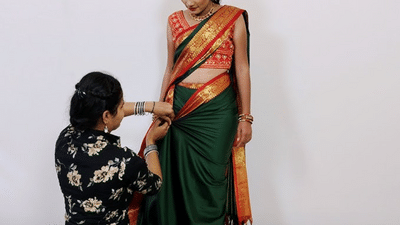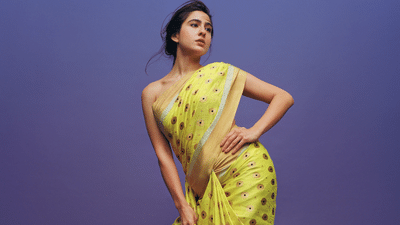With Diwali around the corner, if you’re away from your hometown, it’s the perfect time to celebrate the festival of lights with your colleagues and friends, allowing you to explore your ethnic wardrobe. However, the grace and allure that six yards of saree can exude remain incomparable to any anarkali or farshi salwar.
Although many of us have found ourselves in a space where we’re unable to drape a saree. But not today. Draping a saree that embraces your body and wraps around the curves with pure elegance is no less than an art. As all Indian states have a specific culture and draping style, the most common draping style remains the six pleats detailing at the front and the pallu going from front to back.

Let’s see how to drape a saree step by step, which is perfect for every beginner.
Step 1: Take a saree, which can be 5 to 9 metres long and 3 feet in width. Wear a matching fitted blouse and petticoat. You can also wear a slim-fit saree shaper to get a lean figure, which is tight till the waist.
Step 2: Always start by putting on your footwear, which makes it easier to adjust the height while wearing it. Try to wear a pair of high heels to get a lean posture.
Step 3: Now, let’s get the saree. Opt for a stunning embellished or embroidered saree, and start by putting it on the extreme left side by tucking in the drape. Make sure your ankles aren’t visible, but the height should be comfortable for you to walk.
Step 4: Once you have tucked in the saree, start making the pleats from the front. Use your index finger and pinky finger, and put on 8 to 9 pleats. Once you’re done, tuck it all neatly under the petticoat and secure it with a pin.
Step 5: Now, it's the pallu time. With the remaining saree, you can again create pleats and put them over your left shoulder. Use a safety pin and secure it with the pallu.

Once you’re done, start with your hair and makeup, and get the final look. You can opt for a stunning glittery clutch with your six yards, which will definitely complete the look. For the saree texture, beginners should always work with sarees that have a flowy and soft texture, making them easier to drape and walk in. Opt for silk, satin, georgette, and chiffon primarily, and then you can maybe try organza, cotton, Kanjeevaram, and others, which are a bit structured and heavy.
Although many of us have found ourselves in a space where we’re unable to drape a saree. But not today. Draping a saree that embraces your body and wraps around the curves with pure elegance is no less than an art. As all Indian states have a specific culture and draping style, the most common draping style remains the six pleats detailing at the front and the pallu going from front to back.
Let’s see how to drape a saree step by step, which is perfect for every beginner.
Step 1: Take a saree, which can be 5 to 9 metres long and 3 feet in width. Wear a matching fitted blouse and petticoat. You can also wear a slim-fit saree shaper to get a lean figure, which is tight till the waist.
Step 2: Always start by putting on your footwear, which makes it easier to adjust the height while wearing it. Try to wear a pair of high heels to get a lean posture.
Step 3: Now, let’s get the saree. Opt for a stunning embellished or embroidered saree, and start by putting it on the extreme left side by tucking in the drape. Make sure your ankles aren’t visible, but the height should be comfortable for you to walk.
Step 4: Once you have tucked in the saree, start making the pleats from the front. Use your index finger and pinky finger, and put on 8 to 9 pleats. Once you’re done, tuck it all neatly under the petticoat and secure it with a pin.
Step 5: Now, it's the pallu time. With the remaining saree, you can again create pleats and put them over your left shoulder. Use a safety pin and secure it with the pallu.
Once you’re done, start with your hair and makeup, and get the final look. You can opt for a stunning glittery clutch with your six yards, which will definitely complete the look. For the saree texture, beginners should always work with sarees that have a flowy and soft texture, making them easier to drape and walk in. Opt for silk, satin, georgette, and chiffon primarily, and then you can maybe try organza, cotton, Kanjeevaram, and others, which are a bit structured and heavy.
You may also like

M60 traffic LIVE: Drivers face rush hour chaos as major motorway 'blocked after crash'

Govt attempting to privatise public transport, alleges BRS leader

West Bengal: Two more arrested in BJP MP Khagen Murmu attack case

Ratan Tata's Luxurious Mumbai Home: Who Lives There Now?

IndiGo to increase frequency of flights to Manchester





